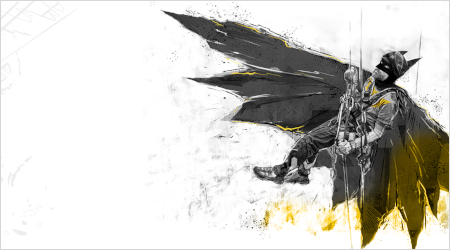Unconventional work at height in tree tops
When Pavel Zoubek from the Liberec ZOO contacted us and told us that he was about to do a research project in Indonesia – placing camera traps in the crowns of trees using the tree climbing technique – we were sure this kind of work at heights would be very interesting. And we also wanted to support nature conservation in this part of our planet.
We questioned Pavel about this project and what it is like to work in the crowns of trees of the Indonesian rainforest.
First of all, Pavel, could you please tell us what kind of research project this is and where it takes place?
The Liberec ZOO puts great emphasis on protection of wildlife. We focus on the area of Central Africa and South East Asia where we have been already working for several years. Currently, we are dealing with the issue of illegal trade with pangolins, which brought us to Mentawai Islands, namely to North and South Pagai. Apart from being a home to pangolins, these islands also accommodate many other endemic and endangered animal species. The most famous are the four species of monkeys which are the symbolic representatives of the local fauna. Let me mention the Kloss's gibbon (Hylobates klossi), for example. I’m sure all climbers would like it a lot. However, with the time spent in a particular place you find more and more topics related to nature conservation and sustainable development. This requires complex approach where cooperation with the local community on research and nature conservation go hand in hand with raising of awareness of these topics.
The islands are still largely covered by forest, which is selectively felled, but still not disturbed by large plantations of agricultural crops, such as oil palm. Yet the wild animals are under huge hunting pressure associated with their traditional consumption. We asked the locals, and it turns out that they often have no idea of how precious species live in their homeland and also that deforestation is pretty common all over Indonesia nowadays. So we decided to start an awareness campaign for the inhabitants of the local islands and conduct it through the local schools and mayors. This would help to draw attention to the richness and uniqueness of the ecosystem in which the locals live. But we needed some material to present.
What made you place camera traps in the crowns of the big trees that you can find in the rainforest?
As primates in the Pagai Islands are one of the most common targets of hunters, monkeys naturally avoid contact with humans and it is very difficult to observe or even photograph them. Most of the local people know monkeys only as a food or as banana thieves. However, if we wanted to create and provide effective educational material which would give the local people a clearer understanding of the life of primates and increase their empathy with the animals, we needed to get to the primates as close as possible: right in the middle of their kingdom in crowns of the trees. Thanks to the camera traps we could get unique shots of these shy primates and use them for educational purposes.
Camera traps have already been used for monitoring of wild animals all over the world but using them in the crowns of trees is still quite a new idea.
Did you have any prior experience with the tree climbing technique?
It was actually our first outdoor experience. Prior to that that we took a tree climbing training at the Singing Rock Polygon which perfectly prepared us for climbing to tree toops. Still, I must admit that if one really wants to do tree climbing, they need to keep learning and training. That’s why we plan to get more training, so that we can learn and grow and use the acquired skills in future.
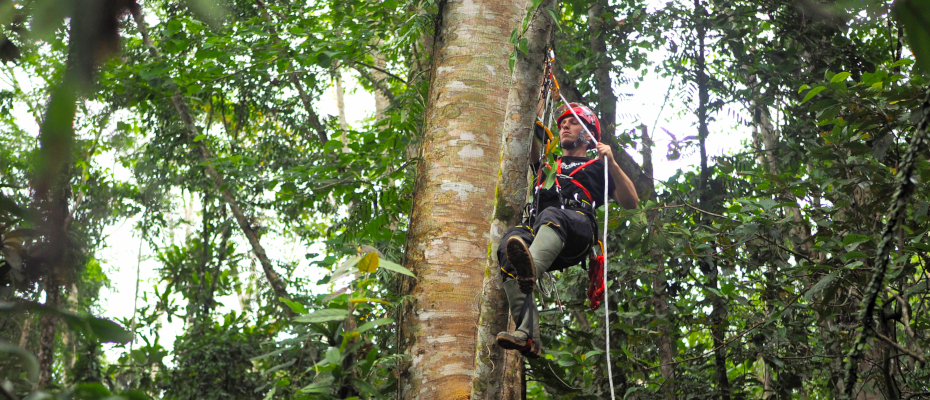
What were the tree climbing conditions like in a rainforest?
The greatest difference between arboriculture and installation of camera traps is that we must first find a suitable tree. This was actually quite challenging for us, as we had to walk in the forest with all our equipment on our backs. Then you must check whether a throwline can be thrown on the tree and if the tree is easy to climb. Climbing on a tree covered with lianas is not a pleasant experience, and primates prefer bare trees anyway. For instance, there is less chance that someone would climb there and surprise them in their sleep. We spent lots of time throwing the throwline. You can only learn this by practice. In the end we were glad to be able to place one camera trap on one tree in one day.
You don't even notice the ubiquitous heat anymore, but the mosquitoes sucking your blood all the time are a real pain. So you need to find some necessary tools – a branch that can be used as a fan and so on. In the tropics rain can come very suddenly. One afternoon we were caught by a heavy rain right in the crowns of trees. We had nowhere to hide so we had first-hand experience of something that the monkeys must deal with on a daily basis. We survived the rain in the crowns, though we were not huddled together like monkeys to keep warm. But we were rewarded by an amazing golden hour and the view of rainforest shrouded in mist.
Many times we had to improvise to get to the spot suitable for placing the camera trap. Once, for example, we were throwing the throwline from a treetop to an even higher tree. And we were damn lucky not to lose a single throwing bag, though sometimes we were pretty close.
Do the locals also use the tree climbing technique? Do they have the necessary equipment?
The local people basically don’t know about any equipment. But they do know how to climb on trees, and they are very nimble. If they need to secure themselves, they just tie rope around their waist – not safe at all. But this is still quite unusual, so they found our equipment very attractive, though unfamiliar. When we come back there, we would like to take some of our assistants to the tree tops with us, so that they can enjoy the view of the rainforest from a height, and perhaps it could add a new dimension to their relationship to nature.
How did our equipment work in such extreme conditions? I guess the rainforest is very hot and damp.
The equipment was 100 % reliable, but we had to take proper care of it. After use we must have cleaned everything and let it air, so it didn't get mouldy. We are wondering, though, how will the equipment, the ropes in particular, work after longer time spent in the tropics. In rainy weather we were also really glad to have waterproof bags with us – that was a big help.
Are you going to remove the installed camera traps from the trees and place them somewhere else? Will the locals help you with that?
We couldn’t do this without the locals. They are basically the cornerstone of all our activities there. They know the environment and can give us advice. Also, we can talk with them about how to protect the wildlife and not to hinder their development at the same time and look for the solutions together. I believe our cooperation is mutually beneficial.
Will you benefit from your new experience with movement at heights in future research?
This was our first pilot project in which we wanted to try this new technique of gathering information about the tree animals and check if it would work in the given conditions. We are really curious about what the records from the camera traps will contain. In future we would like to apply this monitoring method in the long term so that we can estimate the composition and density of the species of the animals living on trees.
And we also plan to create a lookout in the crowns of the trees from where one could see what is going on both in the upper floor of the forest and below. Direct observation is still one of the most effective ways of gathering information about animals. And your presence may discourage potential poachers. We are dealing with a similar issue with our colleagues who are in Kongo. Such lookout would be a great tool for increasing the publicity of this place for keen ecotourists and at the same time it could bring the local inhabitants an alternative way to make living.
Thank you for the interview, Pavel, we will be looking forward to other interesting news from your research and we firmly believe that your activities will contribute to the nature conservation in Indonesia.
More information about the project on the Liberec ZOO website.
Location: Pagai Islands, Indonesia
Research team and photographers: Pavel Zoubek, Tomáš Ouhel, Putra Sabelau, Yerian Ramadhan
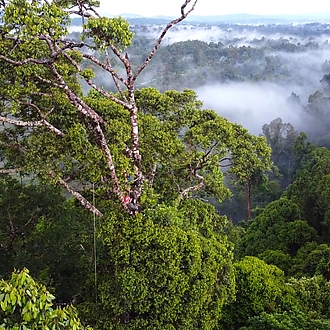
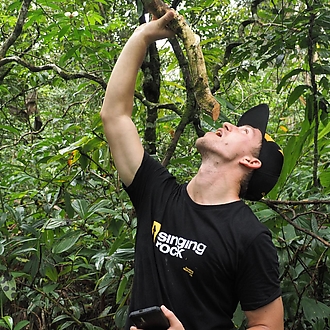
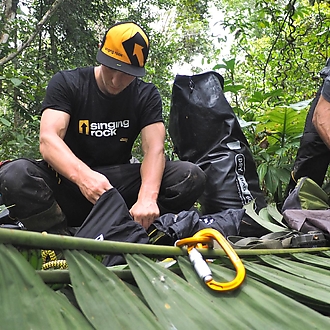
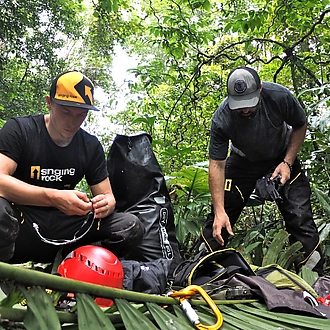
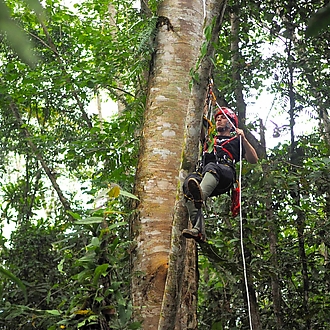
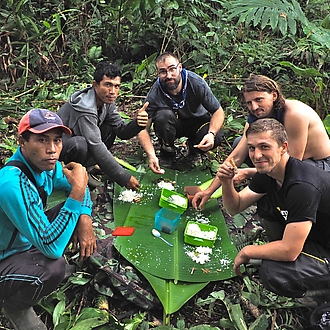
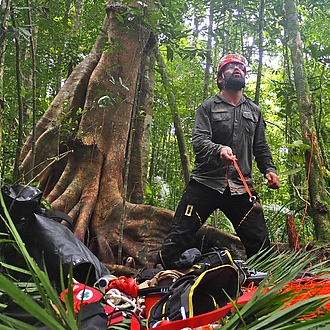
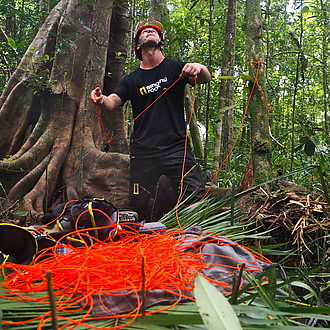 More
More
